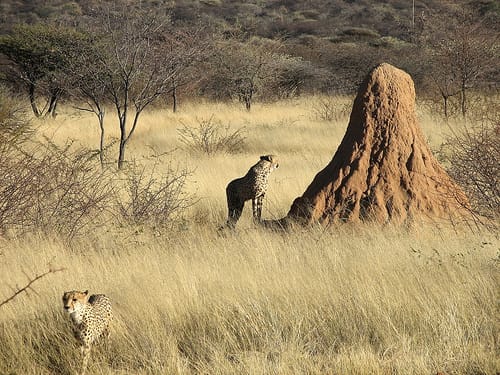The Termite Mine

Bill West Territory, Silobela District, Southern Rhodesia. Bill and his brother Sid were naming their gold mines after the big cats of the area but Bill had a theory…
The Termite Mine
Bill West, despite having no formal training, was a wealthy man. He and his brother Sid owned the Jena Group of gold mines, the Lion, the Leopard and Leopardess in the Silobela District, way beyond Que Que, in the gramadoelas.
The Termite Mine
Bill and his wife Olga did everything well. Olga had an amazing patch of rose bushes set out in neat rows in the vastness of the scrubby savannah. She developed a number of new breeds that she registered with the Royal National Rose Society in St. Albans England. She was working on a black rose, the ultimate challenge for rosarians. Although I was interested in flower arranging, and successfully entered the annual flower show in Que Que, Bill was the main attraction for me.
He was a scientist at heart. I remember occasional family visits for political or medical reasons and spending much time in his museum in a shed behind the house. Rock specimens were laid on rough shelving along the length of the building. He was generous with gifts of specimens of sheets of raw asbestos, plates of mica, chunks of white and rose quartz. I took some of them to America, not once but twice, and eventually gave them to my son, Jonathan.
Bill discovered that termites burrowed down to the water table to fetch water to cultivate the fungus that digested the grass they harvested. Like bees, the ones that fetched water were dedicated to this job. He had pictures from a camera buried in an “anthill” that showed termites with flat abdomens going down and others with enlarged abdomens coming up.
Gold in Rhodesia is found in very ancient greenstone belts, fractured and faulted. Covered by geologically recent shifting Kalahari sand made prospecting rely on visible outcrops. All the gold mines were situated on ancient workings with the exception of the virgin discovery of the Anzac Mine in 1939. Bill was sure there were others to be found if only one could prospect below the sands. He convinced the Department of Mines to fund a program to prove his theory that termites brought up prospecting samples from the water table at the greenstone surface.
In 1970, Bob Atkinson and Martin Fothergill, mining cadets, were allocated to the program. Gangs of local Africans cut transverse lines through the bush. The cadets walked these lines dragging a measuring chain and carrying a magnetometer plotting and sampling the termite mounds along the way. Leaf samples from deep-rooted trees that also reached the water table were also sampled for arsenic, a trace element associated with gold deposits.
The work was tough. Bob and Martin camped in the bush. They were allowed back to town twice a month to stock up on provisions after delivery of samples for analysis. Fortunately Bob was living at a mess at the time and one of the other guys at the mess was the Midlands rep for Rhodesian Breweries. He had unlimited access to beer so his Landrover used to return with its back axle hard against the chassis.
The hard work paid off.
In Gold Deposits of Zimbabwe the note is: “Termite [Mine]. White quartz veins, stringers and lenses in shear zones in carbonated metagabro. Main reef strikes NE, dipping up to 45*NW. Buried under Kalahari sands”.
Up to 1984 it had produced 298kg of gold at a grade of 9.6g/t, certainly a very small mine.
Bob wonders to this day if Bill ever turned a profit on it, but at least he proved his theory.
Many thanks to Bob Atkinson of Pretoria for detailed mining information.
For those who are interested in geological detail click here is an explanation directly from Bob Atkinson:
